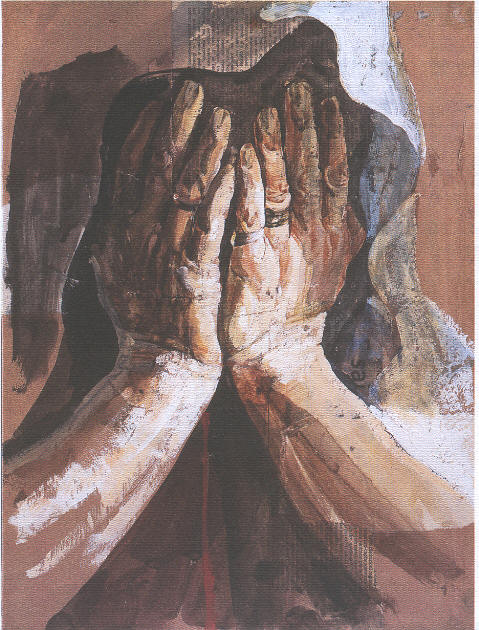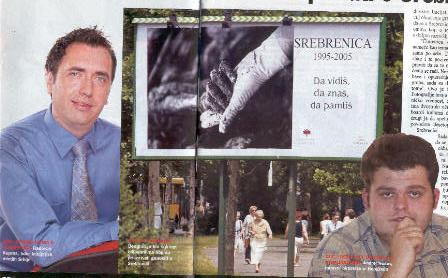 |
Srebrenica in Belgrade
by YIHR
 In the days leading up to the tenth anniversary of the Srebrenica massacre, Belgrade was adorned with twenty-seven giant commemorative billboards, designed by Sarajevo photographer Tarik Samarah and paid for by the recently formed NGO Inicijativa mladih za ljudska prava (Youth initiative for human rights - YIHR), founded by Radovan Kupres, Andrej Nosov and other young Serbian activists. Although most were soon defaced by hate-filled nationalist graffiti - ‘Biće repriza’ [There’ll be an encore], ‘Ratko Mladić’, ‘Nož, žica, Srebrenica’[Knife, wire, Srebrenica] and so on - YIHR, undeterred, proceeded to organize public meetings at which the Women of Srebrenica and massacre survivors spoke. Following a media appeal, they also succeeded in arranging for ten busloads from Belgrade to attend the commemoration ceremony at Potočari on 11 July. In the days leading up to the tenth anniversary of the Srebrenica massacre, Belgrade was adorned with twenty-seven giant commemorative billboards, designed by Sarajevo photographer Tarik Samarah and paid for by the recently formed NGO Inicijativa mladih za ljudska prava (Youth initiative for human rights - YIHR), founded by Radovan Kupres, Andrej Nosov and other young Serbian activists. Although most were soon defaced by hate-filled nationalist graffiti - ‘Biće repriza’ [There’ll be an encore], ‘Ratko Mladić’, ‘Nož, žica, Srebrenica’[Knife, wire, Srebrenica] and so on - YIHR, undeterred, proceeded to organize public meetings at which the Women of Srebrenica and massacre survivors spoke. Following a media appeal, they also succeeded in arranging for ten busloads from Belgrade to attend the commemoration ceremony at Potočari on 11 July.

‘The fact that Srebrenica is imposed on them [people who have never thought seriously about the massacre] as an issue for reflection is good in itself. For if they have all these images and appeals, they can no longer pretend they have never heard about it and don’t know what it’s all about. Some people who don’t want to be concerned or bothered by it - and there are a great many of these - have now received the message: "think about it". This is an open-air exhibition. The photographs have both a documentary and an artistic value, so that the exhibition has a twofold effect. The first is that the billboards are a cultural event for Belgrade, and the second is that we are appealing to the consciousness of citizens on the occasion of the tenth anniversary of the Srebrenica genocide.’
‘Young people here, who were about ten years old when Srebrenica happened and who can in no way be held responsible still less guilty for it, are in great danger because of the great skill and aggressiveness of the campaign by the anti-Hague lobby, which is what we call the array of forces maintaining continuity with the policy of Slobodan Milošević. They are in danger, by swallowing the story about national heroes such as Radovan Karadžić and Ratko Mladić, of precisely buying into collective guilt for themselves and future generations...precisely preventing those generations from being part of the civilized, progressive world. There is a silent mass that is disturbed and scared by the systematic denial and relativization of the truth. We address them.’
Radovan Kupres
‘I was a kid in the nineties. I remember a neighbour of ours from Prokuplja returning from the Vukovar battleground with a jar of what he called ‘Ustasha ears’. Everyone in my neighbourhood admired him. I shall never forget that bearded face of his, in which you could see nothing but hatred. He looked like a Chetnik from one of those films about Chetniks and Partisans. I was really scared every time I passed by his house. I couldn’t understand why he had brought back those ears. I thought he would cut mine off too. This is a horrible story, of course, but I think something happened inside me then, something that perhaps some psychologist might describe, because I can’t put a name to it. I got up one day and realized that I wasn’t going to keep quiet, that I was going at least to try to write something about it, to talk to my friends about it, that I wasn’t going to look on calmly while everyone kept quiet.’
Andrej Nosov
|